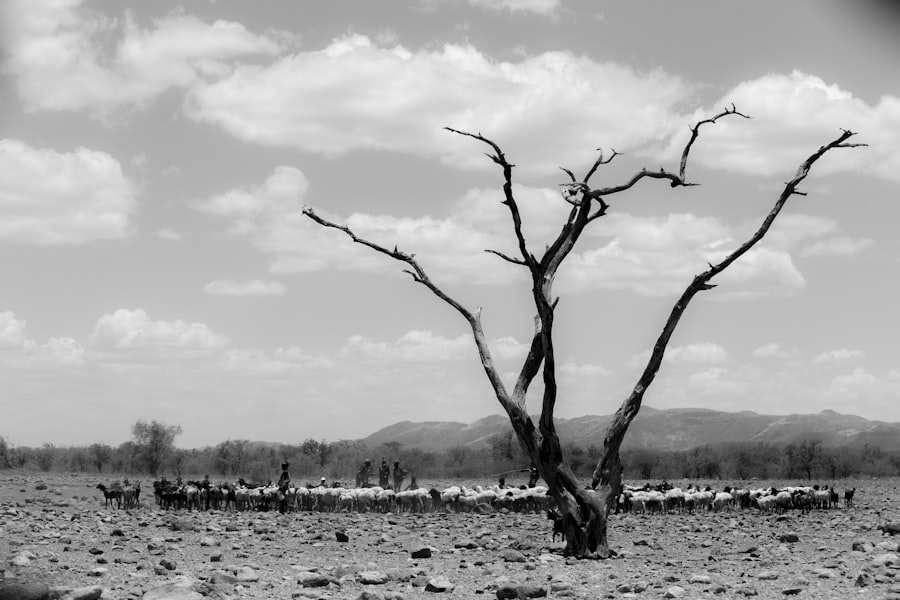
As you delve into the complexities of climate change, one of the most significant impacts you will notice is its effect on growing seasons. Traditionally, farmers have relied on predictable weather patterns to determine when to plant and harvest their crops. However, with the increasing unpredictability of climate conditions, these established timelines are becoming less reliable.
You may find that regions once known for their stable growing seasons are now experiencing shifts that can lead to shorter or longer periods of crop viability. This disruption not only affects agricultural productivity but also poses challenges for food security on a global scale. The implications of these changes extend beyond mere inconvenience.
As you consider the broader picture, you will see that altered growing seasons can lead to a cascade of effects throughout the agricultural supply chain. For instance, if planting is delayed due to unexpected frosts or excessive rainfall, it can result in a domino effect that impacts harvest times, market availability, and ultimately, consumer prices. The unpredictability of climate change forces you to rethink traditional agricultural practices and adapt to a new reality where flexibility and resilience become paramount.
Key Takeaways
- Climate change is impacting growing seasons by altering temperature and precipitation patterns, leading to shortened growing periods and unpredictable weather conditions.
- Changes in temperature and precipitation patterns are affecting the timing and duration of planting and harvesting, as well as the overall productivity and quality of crops.
- Crop yields and quality are being negatively impacted by climate change, leading to potential food shortages and economic losses for farmers.
- Farmers can adapt to shortened growing seasons by implementing strategies such as diversifying crops, using resilient crop varieties, and investing in irrigation and water management systems.
- Innovative farming techniques, such as vertical farming, hydroponics, and agroforestry, can help combat the effects of climate change on agriculture by increasing resilience and sustainability.
Changes in Temperature and Precipitation Patterns
When you examine the changes in temperature and precipitation patterns, it becomes clear that these factors are at the heart of climate change’s impact on agriculture. Rising global temperatures are leading to hotter summers and milder winters, which can alter the physiological processes of plants. You may notice that certain crops thrive in warmer conditions, while others struggle to survive.
This shift can create a mismatch between crop varieties and the climatic conditions they were originally bred for, leading to potential declines in agricultural productivity. Moreover, precipitation patterns are becoming increasingly erratic. You might experience periods of intense rainfall followed by prolonged droughts, creating a challenging environment for farmers.
These fluctuations can lead to soil erosion, nutrient depletion, and water scarcity, all of which directly affect crop health and yield. As you consider these changes, it becomes evident that understanding local climate patterns is essential for effective farming practices. Farmers must adapt their strategies to account for these variations, ensuring they can maintain productivity despite the challenges posed by climate change.
Effects on Crop Yields and Quality

As you explore the effects of climate change on crop yields and quality, you will find that the consequences are profound and multifaceted. Changes in temperature and precipitation not only influence how much food is produced but also the nutritional value of that food. For instance, higher temperatures can lead to reduced yields of staple crops like wheat and corn, while also affecting their quality by altering protein content and other essential nutrients.
This decline in both quantity and quality can have serious implications for food security, particularly in regions that rely heavily on these crops for sustenance. Additionally, you may observe that climate change is fostering an environment conducive to pests and diseases that threaten crops. Warmer temperatures can expand the range of certain pests, allowing them to thrive in areas where they were previously limited by colder climates.
This increased pressure on crops can lead to further reductions in yield and quality, compounding the challenges faced by farmers. As you reflect on these issues, it becomes clear that addressing the impacts of climate change on agriculture requires a comprehensive understanding of both environmental factors and agricultural practices.
Strategies for Adapting to Shortened Growing Seasons
In light of the challenges posed by shortened growing seasons, it is crucial for farmers to develop effective strategies for adaptation. One approach you might consider is diversifying crop rotations. By planting a variety of crops with different growing requirements, you can mitigate the risks associated with climate variability.
This strategy not only helps maintain soil health but also provides a buffer against potential crop failures due to adverse weather conditions. Another adaptation strategy involves selecting crop varieties that are more resilient to changing climatic conditions. You may find that certain genetically modified or hybrid crops are better suited for shorter growing seasons or extreme weather events.
By investing in research and development, farmers can access new technologies that enhance crop resilience and ensure food production remains stable despite the challenges posed by climate change. As you explore these strategies, it becomes evident that proactive measures are essential for maintaining agricultural productivity in an uncertain future.
Innovative Farming Techniques to Combat Climate Change
As you navigate the landscape of modern agriculture, innovative farming techniques emerge as vital tools in combating climate change. One such technique is precision agriculture, which utilizes technology to optimize field-level management regarding crop farming. By employing sensors, drones, and data analytics, you can monitor soil health, moisture levels, and crop growth in real-time.
This information allows for more efficient use of resources such as water and fertilizers, ultimately reducing environmental impact while maximizing yields. Additionally, regenerative agriculture practices are gaining traction as a means to restore soil health and sequester carbon dioxide from the atmosphere. Techniques such as cover cropping, reduced tillage, and agroforestry not only enhance biodiversity but also improve soil structure and fertility.
As you consider these innovative approaches, it becomes clear that embracing new technologies and sustainable practices is essential for building resilience against climate change while ensuring food security for future generations.
Policy and Government Initiatives to Support Farmers

The role of policy and government initiatives cannot be overstated when it comes to supporting farmers in adapting to climate change. You may find that various programs aim to provide financial assistance for implementing sustainable practices or investing in research and development. These initiatives can help alleviate some of the economic burdens associated with transitioning to more resilient agricultural methods.
Moreover, government policies can play a crucial role in promoting education and awareness about climate change impacts on agriculture. By providing resources and training for farmers, policymakers can empower them to make informed decisions about their practices. As you reflect on these initiatives, it becomes evident that collaboration between governments, agricultural organizations, and farmers is essential for creating a supportive environment that fosters innovation and resilience in the face of climate change.
The Role of Technology in Mitigating the Effects of Climate Change on Agriculture
In your exploration of technology’s role in agriculture, you will discover that advancements are crucial for mitigating the effects of climate change. From precision farming tools to advanced breeding techniques, technology offers solutions that can enhance productivity while minimizing environmental impact. For instance, remote sensing technology allows farmers to monitor crop health from afar, enabling timely interventions that can prevent losses due to pests or diseases.
Furthermore, biotechnology plays a significant role in developing crops that are more resistant to extreme weather conditions. You may find that genetically modified organisms (GMOs) are designed to withstand droughts or floods, ensuring food production remains stable even in challenging climates. As you consider these technological advancements, it becomes clear that embracing innovation is essential for building a sustainable agricultural future capable of withstanding the pressures of climate change.
The Importance of Sustainable Agriculture Practices in a Changing Climate
As you reflect on the importance of sustainable agriculture practices in a changing climate, it becomes evident that these methods are not just beneficial but necessary for long-term viability. Sustainable practices focus on maintaining ecological balance while ensuring economic viability for farmers. By prioritizing soil health, water conservation, and biodiversity, you contribute to a more resilient agricultural system capable of adapting to climate variability.
Moreover, sustainable agriculture practices often lead to improved food quality and safety. By reducing reliance on chemical inputs and promoting organic farming methods, you can enhance the nutritional value of crops while minimizing environmental harm. As you consider your role in this evolving landscape, it becomes clear that adopting sustainable practices is not only an ethical choice but also a practical one for ensuring food security in an uncertain future.
In conclusion, as you navigate the complexities of climate change’s impact on agriculture, it is essential to recognize the interconnectedness of various factors at play. From shifting growing seasons to innovative farming techniques and supportive policies, each element plays a crucial role in shaping the future of food production. By embracing adaptability and sustainability, you can contribute to a resilient agricultural system capable of thriving amidst the challenges posed by climate change.
A related article to Climate Change and Agriculture: When Growing Seasons Vanish can be found at Advantages of Planting Trees for Climate Change. This article discusses the benefits of planting trees in combating climate change and how it can help mitigate the effects of a changing climate on agriculture. By planting trees, we can help reduce carbon dioxide levels in the atmosphere and create a more sustainable environment for future generations.
FAQs
What is climate change?
Climate change refers to significant and long-term changes in the Earth’s climate, including changes in temperature, precipitation, and wind patterns. These changes are largely attributed to human activities, such as the burning of fossil fuels and deforestation, which release greenhouse gases into the atmosphere.
How does climate change affect agriculture?
Climate change can have a significant impact on agriculture by altering growing seasons, increasing the frequency and severity of extreme weather events, and affecting water availability. These changes can lead to reduced crop yields, decreased livestock productivity, and increased pest and disease pressure.
What are the implications of vanishing growing seasons on agriculture?
Vanishing growing seasons can have serious implications for agriculture, including reduced crop yields, shifts in planting and harvesting schedules, and increased vulnerability to extreme weather events. This can lead to food shortages, increased food prices, and economic hardship for farmers and rural communities.
How can agriculture adapt to vanishing growing seasons?
Agriculture can adapt to vanishing growing seasons by implementing practices such as crop diversification, improved water management, and the use of heat and drought-resistant crop varieties. Additionally, investing in climate-resilient infrastructure and technologies can help farmers mitigate the impacts of vanishing growing seasons.
What are some potential solutions to mitigate the impact of climate change on agriculture?
Some potential solutions to mitigate the impact of climate change on agriculture include reducing greenhouse gas emissions, promoting sustainable land management practices, and investing in climate-smart agricultural technologies. Additionally, supporting smallholder farmers and building resilience in agricultural systems can help mitigate the impact of climate change on food security.





